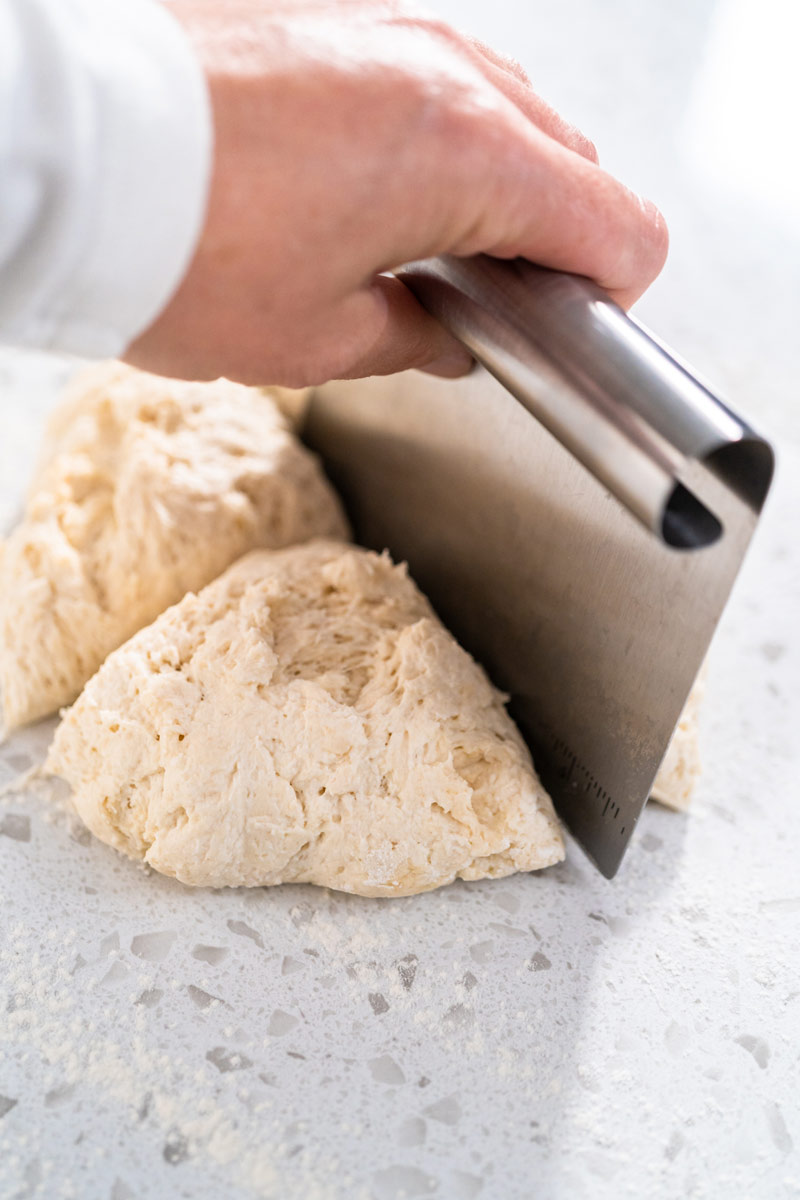Iced Blueberry Scones Recipe, Spotlight on Blueberries and Bench Scrapers, Managing Depression with Scents, and Resistance Training for Anxiety
May is Mental Health Awareness Month, first established in 1949 to increase our understanding of the vital role mental health plays in overall health and well-being and to celebrate recovery from mental illness. With all the stresses of daily living we face today, addressing mental health has never been as important. So, in addition to my recipe for scones, I’m including two different advances in mental health care that could impact how depression and anxiety are managed.
Iced Blueberry Scones
 Iced Blueberry Scones
Iced Blueberry SconesIf you’ve ever had a store-bought scone, chances are it was dry and crumbly. My recipe is flaky yet still tender, thanks to the olive oil in the pastry flour dough. A light icing drizzle balances out the tartness of blueberries.
Ingredients
For the Scones:
- 2 cups pastry flour, plus more for the cookie sheet and shaping the dough
- 1/4 cups whole wheat pastry flour
- 1/3 cup sugar
- 1 tablespoon baking powder
- 1 teaspoon coarse sea salt
- 1/2 cup extra virgin olive oil
- 2/3 cup half-and-half
- 1 extra-large egg
- 1 teaspoon vanilla
- 1 cup fresh blueberries, rinsed and patted dry
For the Glaze:
- 1 cup confectioners’ sugar
- 1 tablespoon freshly squeezed lemon juice
Directions
Step 1
Preheat your oven to 400°F. Line a cookie sheet with parchment paper and sprinkle it liberally with flour.
Step 2
Place the 2-1/4 cups flour (pastry and whole wheat), sugar, baking powder, and salt in a mixing bowl and whisk to combine. In a separate bowl, thoroughly whisk the olive oil, half-and-half, egg, and vanilla. Using a large spatula, fold in the blueberries and then the flour mixture. Be careful not to overmix, which can cause too much gluten development and a dense scone.
Step 3
Turn the dough out onto the parchment paper. Heavily flour your hands and use them to pat the dough into a 12-by-8-inch rectangle (do not use a rolling pin). If the dough is extremely wet, sprinkle on a tablespoon of additional flour. Use a bench scraper to help even out the edges, cut the dough into 12 triangles or squares, and then move the pieces as needed to leave about two inches between them.
Step 4
While the scones are cooling, mix the confectioner’s sugar and lemon juice, thinning if needed with 1 tablespoon of water. Use a spoon to drizzle on the icing in a crisscross pattern.
Step 5
Serve warm or at room temperature. Store any leftovers in the fridge.
Yields 12 scones

Healthy Ingredient Spotlight
Frozen Blueberries
Blueberries are more than delicious—they’re at the top of many healthiest-foods lists because of their amazing nutrients. Along with vitamins C and K and the mineral manganese, they’re rich in anthocyanins, which give them their blue-purple color and protect cells from damaging molecules called free radicals. Their soluble fiber helps lower blood sugar, manage blood pressure, and sweep out cholesterol, which, in turn, can lower the risk for heart disease.
Spring is the start of blueberry season, but when fresh ones aren’t available, frozen ones make a great stand-in (it’s also smart to freeze fresh berries you grow or buy throughout the summer so that you’ll have them for next fall and winter). Bakers are often disappointed by the bleeding frozen berries can cause, creating streaks of purple or even green in the finished baked goods. This doesn’t affect taste, but here’s a quick hack to avoid it: Just before adding them to your batter, rinse the frozen berries well in cold water and then thoroughly pat them dry between layers of paper towels. Quickly fold them into the batter using just a few strokes. Keep in mind that you are rinsing away some of the berries’ healthful anthocyanins, so if the streaks don’t bother you, simply pat defrosted berries with paper towels before adding them to the batter to avoid adding excess moisture.

Quick Kitchen Nugget
The Value of a Bench Scraper
This lightweight tool, designed to help you move dough when working on a countertop or “bench,” does more than its name indicates. Press the side against your dough to even its sides—this may eliminate the need for trimming the edges. Use the edge of the scraper to cut dough into scones, biscuits, bar cookies, or crackers. Also, the flat side works like a metal spatula to transfer dough pieces to your baking sheet. Available at most housewares stores and online, a good stainless steel bench scraper runs $10-$15.


For Your Best Health
Managing Depression: Using Scents to Unlock Memories
A study done by University of Pittsburgh School of Medicine researchers and University of Pittsburgh Medical Center social workers and published in JAMA Network Open has found that scents are more effective than words at calling up a memory of a specific event. Scents could even be used to help people experiencing depression get out of negative thought cycles and rewire thought patterns, aiding faster and smoother healing.
Early in her career, Kymberly Young, PhD, a neuroscience researcher who studies autobiographical memories, realized that engaging the amygdala, the part of the brain that not only controls the fight-or-flight response but also directs attention and focus to important events, helps with memory recall.
She also knew of extensive evidence that people with depression have a hard time recalling specific autobiographical memories and that, in healthy individuals, odors trigger memories that feel vivid and real, likely because they directly engage the amygdala through nerve connections from the olfactory bulb.
“It was surprising to me that nobody thought to look at memory recall in depressed individuals using odor cues before,” said Dr. Young, senior author of the study and associate professor of psychiatry at Pitt. So, she decided to test whether engaging the amygdala could help depressed individuals access their memories more effectively.
Rather than start with brain scanner tests, she decided to go low tech, presenting study participants with a series of opaque glass vials containing potent familiar scents including everything from oranges and ground coffee to shoe polish and even Vicks VapoRub.
After asking participants to smell a vial, Dr. Young asked them to recall a specific memory, good or bad. She was surprised to discover that memory recall was stronger in depressed individuals who received odor cues as opposed to word cues. Also, those who received odor cues were more likely to recall a memory of a specific event (for example, that they went to a coffee shop the previous Friday) than general memories (that they have been to coffee shops before). Memories spurred by odors were also a lot more vivid and felt more immersive. Even though Dr. Young did not direct participants to specifically recall positive memories, her results found that positive memories were more likely to be recalled.
Dr. Young will soon start more technologically advanced studies using a brain scanner, but she is excited about the progress already made. “If we improve memory, we can improve problem-solving, emotion regulation, and other functional problems that depressed individuals often experience,” she said.

Fitness Flash
Resistance Training for Anxiety
Researchers Matthew P. Herring, PhD, of the University of Limerick (UL) in Ireland, and Jacob D. Meyer, PhD, of Iowa State University (ISU), recently published an article in the journal Trends in Molecular Medicine to review evidence supporting the positive effects that resistance exercise training can have on anxiety and depression.
“There is a critical need for confirmatory, definitive trials that adequately address limitations [of existing research], but the limited evidence available to us provides initial support for the beneficial effects of resistance exercise training on these mental health outcomes, including increased insulin-like growth factor 1, cerebrovascular adaptations, and potential neural adaptations influenced by controlled breathing inherent to resistance exercise,” explained Dr. Herring, associate professor in the Physical Activity for Health Research Centre, Health Research Institute, and department of physical education and sport sciences within the faculty of education and health sciences at UL, and a fellow of the American College of Sports Medicine.

“Notwithstanding the limitations of the limited number of studies to date, there is exciting evidence, particularly from our previous and ongoing research of the available studies, that suggests that resistance exercise training may be an accessible alternative therapy to improve anxiety and depression. Anxiety and depressive symptoms and disorders are prevalent and debilitating public health burdens for which successful treatment is limited,” Dr. Herring said. “A more exciting aspect is that there is substantial promise in investigating the unknown mechanisms that may underlie these benefits to move us closer to maximizing benefits and to optimizing the prescription of resistance exercise via precision medicine approaches.”
“The current research provides a foundation for testing if resistance training can be a key behavioral treatment approach for depression and anxiety,” said Dr. Meyer, an expert on the neurobiological effects of exercise on depression and director of ISU’s Wellbeing and Exercise Laboratory, focused on understanding how exercise and sedentary activities are related to mental health and well-being. “As resistance training likely works through both shared and distinct mechanisms to achieve its positive mood effects compared to aerobic exercise, it has the potential to be used in conjunction with aerobic exercise or as a stand-alone therapy for these debilitating conditions. Our research will use the platform established by current research as a springboard to comprehensively evaluate these potential benefits of resistance exercise in clinical populations while also identifying who would be the most likely to benefit from resistance exercise.”
Get More Recipes In Your Inbox!